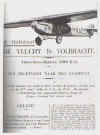|
Fokker
planes (civil)
1918
After WWI the
enormous production came to an end. Fokker had to enter a new road. He
decided to start with developing passengerairplanes. That turned out to
be a smart choice for there wasn't any other company doing the same
thing yet.
The fuselage
was made of steel rods covered with linnen and wooden wings. This way of
building was maintained until WWII.
F.II
The mother of all Fokker planes. It was his first real passenger plane.
The first version had room for 6 passenger, but it had an open cabin.
That's why this version never made it. The design was altered and the
result was an F.II that could carry 5 passengers; 4 in a closed cabin
and one next to the pilot. Approximately 30 F.II were built. In 1920 KLM
bought two F.II's. (Royal Dutch Airlines)

C.II
Apart from the F.II, Fokker also
built the C.II. The C.II was originally a militairy plane which was
altered. It had a funny looking cabin for two.
1919
Fokker
established his firm in the Netherlands.
1921
F.III
The
successor of the F.II. It strongly resembled the F.II, with the
exception of its size; the F.III was a bit larger. The cabin had room
for 5 passengers. The pilot wasn't seated behind the engine, but next to
it. The cockpit was still open, so the poor fellow was exposed to the
elements.
Fokker nearly
sold 40 F.III's to KLM, but also to Germany, Hungary and Russia.
1922
The number of
airlinecompany's slowly increased as did the number of passengers.
Fokker thought ahead and ordered to design a larger plane; the F.IV
which could carry up to 10 passengers.
Unfortunately
Fokker had been too progressive; he barely got orders for this plane.
That's why only 2 of them were built for the American army. One of them
ended up as an ambulance airplane. The other one got its fame due to a
non-stop flight from San Diego to New York on may 2nd and 3rd
1922. Some time later it broke a timerecord by staying in the air for 36
hours non stop.
The F.V
was designed. It
had room for 8 passengers and 2 pilots. This plane was not based on its
predecessor. The F.V was a bi-plane which could also fly as a mono-plane
by dismounting the lower wing. The fuselage was covered with three-ply
board in stead of linnen. The F.V even had a toilet on board. In spite
of everything Fokker was never content with this plane and it never
became a succes. Fokker built only one F.V.
1923
F.VII
This
plane had 4x2 seatsstoelen and double stearing. This plane was meant for
long distances, hence the two pilots. Like its predecessor it had a
toilet. It was a very progressive model for those days.
1924
The first
F.VII,
the H-NACC was airborne in april 1924. In June 1924 the KLM used
this plane for its flights from/to Amsterdam -London. With its flight to
the Dutch Indies it gathered a lot of fame. The newpapers wrote
" Holland and the Dutch Indies connected by air".

More Information will be added
at a later time

|